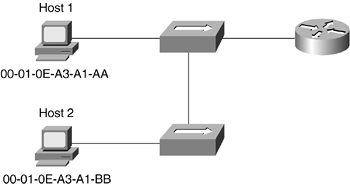Understanding Legacy LAN Segment
In a VLAN environment, a user can be situated physically anywhere in the network, and still be part of a group of users that have the same requirements such as IP addressing and specific network privileges. In legacy networks, hosts with similar network requirements had to be on the same LAN segment. On the other hand, VLANs are logical and not bound to any physical location.
In legacy networks, users connected to a hub, which may have been connected to some kind of bridge or router if wide-area connectivity was required (see Figure 4-1). Multiple hubs were interconnected to allow more users on the same segment.
Figure 4-1. Multiple Hubs Connected to a Router or Bridge

This type of network enabled a department with a large number of users to remain part of the same segment. This setup was easy for a network engineer to implement, because generally one network configuration was supported for that department. For example, the department likely had local file servers on the same Layer 2 segment allowing most, if not all, traffic to stay local.
Cascading hubs allow more users to be on the same segment at the cost of causing more contention among hosts trying to access the network. A bigger collision domain translates to more packet collisions on the network, and, therefore, more retransmissions and possible packet drops. By cascading multiple hubs, the possibility of exceeding the cabling requirements of IEEE 802.3 standard exists, which translates to late collisions, causing packet loss. A defective network interface card (NIC) that "jabbers" can cause severe performance issues on this type of network because it continuously sends garbled data, ignoring the carrier sense multiple access collision detect (CSMA/CD) rule that you learned about in Chapter 1, "LAN Switching Foundation Technologies."







